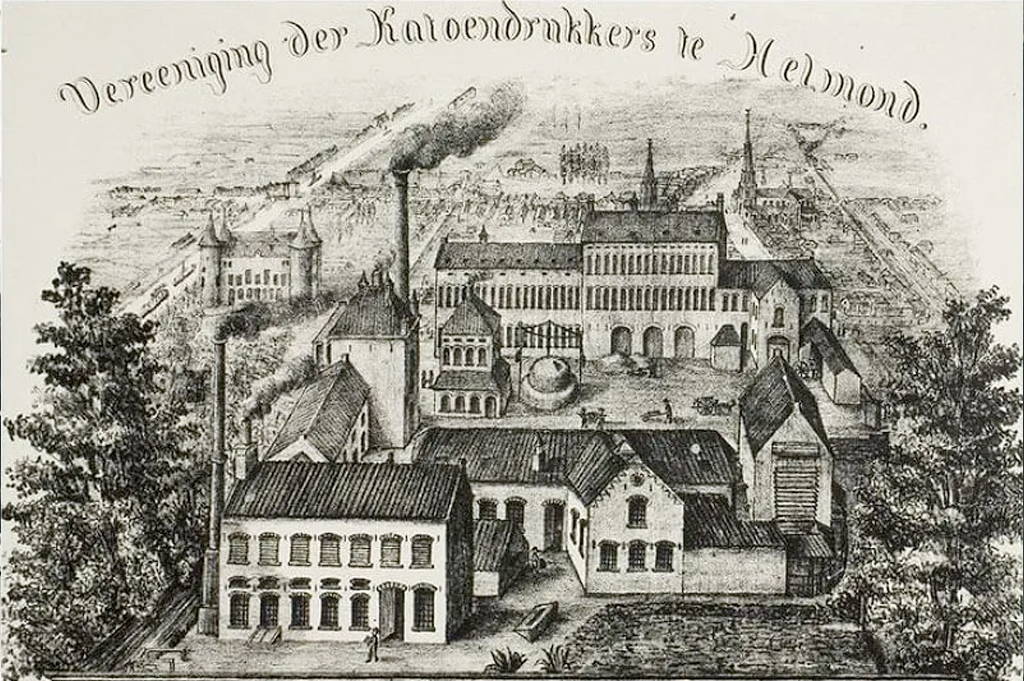Made in The Netherlands
A small town factory in Holland might not seem like the obvious birthplace for African haute couture...

The Birthplace
In the heart of the Netherlands lies a humble town named Helmond, an unlikely birthplace for what would become the epitome of African haute couture. This unassuming locale holds the origins of one of West and Central Africa's most iconic fashion brands – Vlisco. Though often overlooked on the map by both Dutch and African alike, Helmond boasts a legacy spanning nearly 170 years in the textile industry, supplying fashion prints to nearly half a continent.

The Vlisco factory between 1950 -1960
Vlisco and it's History
Vlisco's journey to becoming the premier supplier of wax print fashion fabrics to West and Central Africa was serendipitous. Originally setting its sights on the Indonesian market, the company stumbled upon its destiny in African textiles. In 1864, Amsterdam entrepreneur Pieter Fentener van Vlissingen took the helm of a small textile-press company in Helmond, inspired by his uncle's experiences in the Dutch East Indian colonies.
Their initial attempt to replicate traditional Indonesian Batik for the Dutch East Indies market fell short of expectations. However, African buyers saw beauty in imperfection, appreciating the uniqueness of each piece and the double-sided printing ideal for traditional wrapped fashion styles. The wax print fabrics, initially intended for trade in Indonesia, found a new home in Africa, evolving into luxury items affectionately dubbed the "Chanel of Africa."
Failing to make an impact in Indonesia, Vlisco pivoted to cater to the African market, adapting their designs to meet local preferences for bold colors and prints. By 1894, they became the first Dutch fabric factory to establish their design team. By 1930, Vlisco had solidified its position as a luxury fashion brand in West and Central Africa, with a vast market encompassing countries like Ivory Coast, Nigeria, Ghana, and Congo.
Their initial attempt to replicate traditional Indonesian Batik for the Dutch East Indies market fell short of expectations. However, African buyers saw beauty in imperfection, appreciating the uniqueness of each piece and the double-sided printing ideal for traditional wrapped fashion styles. The wax print fabrics, initially intended for trade in Indonesia, found a new home in Africa, evolving into luxury items affectionately dubbed the "Chanel of Africa."
Failing to make an impact in Indonesia, Vlisco pivoted to cater to the African market, adapting their designs to meet local preferences for bold colors and prints. By 1894, they became the first Dutch fabric factory to establish their design team. By 1930, Vlisco had solidified its position as a luxury fashion brand in West and Central Africa, with a vast market encompassing countries like Ivory Coast, Nigeria, Ghana, and Congo.

The early years of making African wax prints
Yet, it is not just Vlisco that shapes African fashion; it is the African women themselves who infuse high fashion into the brand. Celebrating individuality and empowerment through fashion, women collaborate with local designers to craft their unique couture pieces. Moreover, the fabrics themselves hold symbolic significance, with each print assigned names and meanings by the wearers, reflecting personal stories and cultural heritage.
Despite facing challenges from cheap imitations flooding the market, Vlisco persevered, reinventing itself as a full-fledged fashion brand under the ownership of British investment group Actis. Through strategic initiatives like collaborations with young designers and partnerships with renowned fashion houses, Vlisco solidified its position as a high-end fashion brand, earning recognition from global fashion icons like Junya Watanabe and Jean Paul Gaultier.
Despite facing challenges from cheap imitations flooding the market, Vlisco persevered, reinventing itself as a full-fledged fashion brand under the ownership of British investment group Actis. Through strategic initiatives like collaborations with young designers and partnerships with renowned fashion houses, Vlisco solidified its position as a high-end fashion brand, earning recognition from global fashion icons like Junya Watanabe and Jean Paul Gaultier.

An early sketch of Vlisco's factory in the 1800's. Courtesy picture: Vlisco.com
Vlisco & Today
Today, Vlisco continues to inspire and innovate, weaving a narrative of cultural pride, empowerment, and creativity through its iconic African fabrics. As its prints adorn runways and wardrobes worldwide, Vlisco's legacy serves as a testament to the enduring power of African fashion and the indomitable spirit of the continent's people.
Join the community
Follow us on our Hilton Textiles Instagram channel, and discover all the latest fabrics and promotions, including exclusive designs only sold at Hilton Textiles. Also, check out our Facebook page and subscribe here to see all updates.
